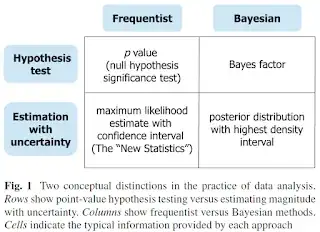I come from a frequentist mindset by training, unfortunately. As such, I'm conditioned to interpret experimental results as either a) reject some null hypothesis, or b) fail to reject it, all based on a 95% level of confidence. I wish to understand how to interpret the results of basic Bayesian analyses, specifically credible intervals. In lieu of a frequentist technique (i.e. Fisher's Exact Test), I present the following example with a Bayesian approach.
A survey of aliens on two planets were asked if they eat apple pie:
$$\begin{array}{rcc} & \text{Yes} & \text{No} & \text{Total}\\ \hline \text{Martians} & 16 & 36 & 52\\ \text{Venusians} & 9 & 34 & 43\\ \text{Total} & 25 & 70 & 95\\ \hline \end{array}$$
$\mathbf{Hypothesis}$
The statistical hypothesis I wish to investigate is whether the proportion of Martians who eat apple pie is greater than Venusians who also eat apple pie.
$\mathbf{Beta{-}Binomial\ Model}$
The observed data has a total of $n_1=52$ Martians and $y_1=16$ eat apple pie. Also, we have $n_2=43$ Venusians and $y_2=9$ eat apple pie.
Let $\theta_1 \in [0,1]$ be the proportion of Martian pie-eaters and $\theta_2 \in [0,1]$ be Venusian pie-eaters. We model the pie-eaters as binomials:
$y_1 \sim \text{Binom}(n_1,\theta_1)$ and
$y_2 \sim \text{Binom}(n_2,\theta_2)$ and
Assume simple uniform priors on the proportions, which we know are equivalent to $\text{Beta}(1,1)$ priors:
$\theta_1 \sim \text{Unif}(0,1)=\text{Beta}(1,1)$ and
$\theta_2 \sim \text{Unif}(0,1)=\text{Beta}(1,1)$.
The beta distribution is a conjugate prior to the binomial: the resulting posterior is also a beta distribution. Thus, we can we can analytically compute the posteriors:
$p(\theta_1\mid y_1,n_1)=\text{Beta}(\theta_1\mid y_1+1,n_1-y_1+1)$ and
$p(\theta_2\mid y_2,n_2)=\text{Beta}(\theta_2\mid y_2+1,n_2-y_2+1)$
We could try to compute the posterior density of $\delta=\theta_1-\theta_2$ by solving the integral
$p\left( {\delta\mid y,n} \right) = \int_{ - \infty }^\infty {{\rm{Beta}}} \left( {\theta\mid {y_1} + 1,{n_1} - {y_1} + 1} \right){\rm{Beta}}\left( {\theta - \delta\mid {y_2} + 1,{n_2} - {y_2} + 1} \right)d\theta$
and then evaluate
$\rm{Pr}[\delta>0$].
Instead, we will estimate the integral by simulation. Take $M$ samples from the joint posterior
$p(\theta_1,\theta_2\mid y_1,n_1,y_2,n_2)=p(\theta_1\mid y_1,n_1)\times p(\theta_2\mid y_2,n_2)$,
which we express as
$(\theta_1^{(1)}, \theta_2^{(1)}), (\theta_1^{(2)}, \theta_2^{(2)}), (\theta_1^{(3)}, \theta_2^{(3)}),..., (\theta_1^{(M)}, \theta_2^{(M)})$
and compute the Monte-Carlo approximation
$\Pr \left[ {{\theta _1} > {\theta _2}} \right] \approx \frac{1}{M}\sum\nolimits_{m = 1}^M \mathbb{I} \left( {\theta _1^{\left( m \right)} > \theta _2^{\left( m \right)}} \right)$.
where $\mathbb{I}()$ is the indicator function which takes on the value 1 if its property is true and 0 if false.
All of that to say, we will estimate the probability that $\theta_1$ is greater than $\theta_2$ by the proportion of samples $m \in M$ where $\theta_1^{(m)}> \theta_2^{(m)}$.
$\mathbf{R\ code}$
### DATA
n1 = 52 # total number of Martians in the survey
y1 = 16 # number of Martians who eat apple pie
n2 = 43 # number of Venusians in the survey
y2 = 9 # number of Venusians who eat apple pie
### SIMULATION
R <- 100000 # number of simulations
theta1 <- rbeta(R, y1 + 1, (n1 - y1) + 1)
theta2 <- rbeta(R, y2 + 1, (n2 - y2) + 1)
diff <- theta1 - theta2 # simulated differences
quantiles <- quantile(diff,c(0.005,0.025,0.5,0.975,0.995))
print("Quantiles:")
quantiles
print("The probability that Martians eat apple pie to a greater extent compared to Venusians is:")
mean(theta1 > theta2)
print("The mean difference (theta1, theta2) is:")
mean(theta1 - theta2)
print("The median difference (theta1, theta2) is:")
median(theta1 - theta2)
### 95% CREDIBLE INTERVALS
# theta1
theta1ci <- quantile(theta1, c(0.025, 0.975))
theta1ci
# theta2
theta2ci <- quantile(theta2, c(0.025, 0.975))
theta2ci
### Comparison to specific computed instances of the beta distribution
### 95% Bayesian probability interval estimate
### See the following post for inspiration:
### https://math.stackexchange.com/questions/2704347/bayesian-confidence-interval-estimate-of-theta
# Martians
qbeta(c(.025,.975), 17, 37)
# Venusians
qbeta(c(.025,.975), 10, 35)
# VISULIZATION
# library(Cairo)
# CairoPDF(file = "bayes-contingency-cairo.pdf", family = "Helvetica")
plot(density(diff),
xlab = "theta1 - theta2",
ylab = "p(theta1 - theta2 | y, n)",
main = "Applie Pie Consumption: \nPosterior Simulation of Martians vs. Venusians",
ylim = c(0, 5),
frame.plot = FALSE, cex.lab = 1.5, lwd = 3, yaxt = "no")
abline(v = quantiles[2], col = "blue")
abline(v = quantiles[4], col = "blue")
# dev.off()
$\mathbf{The\ Big\ Questions}$
After running the sumulation, we see that the credible intervals of Martians $\theta_1:[0.1988685, 0.4432125]$ and Venusians $\theta_2:[0.1139820, 0.3532699]$ overlap. In frequentist statistics, "confidence" intervals which overlap indicate non-significance.
1) How would I interpret these "credible" intervals from a Bayesian perspective?
2) There is an 85.4% chance that a higher prevalence of apple pie eating exists amongst Marians compared to Venusians. Although this percentage is not greater than 95% a la frequentist interpretation, how would one explain that this result is "significant"? Or, perhaps this finding is not worthy of further consideration since it is <95%?
